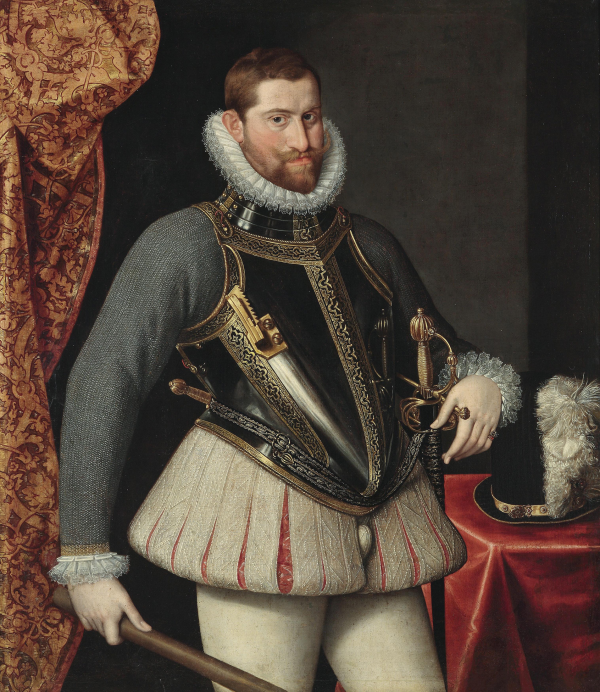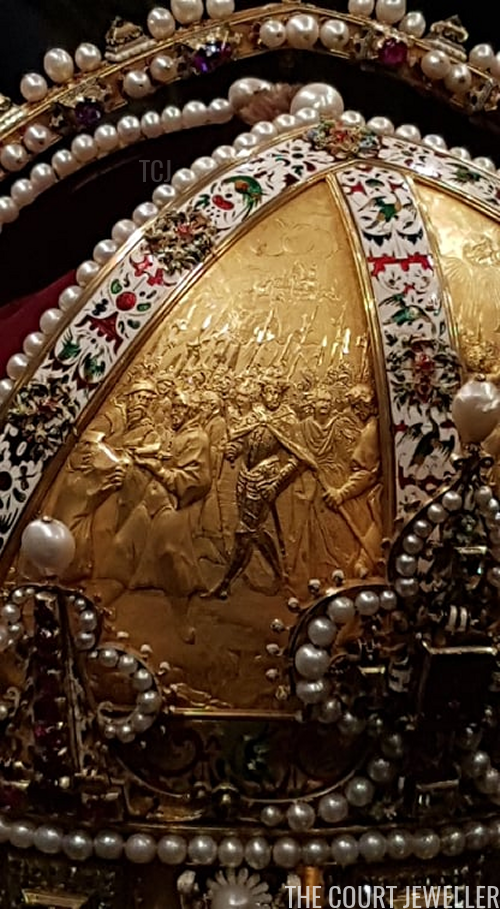 |
| Photo generously shared by reader Lisa |
Because it’s tough for many of us to travel right now, I’ve got a special treat: a two-part tour of some of the spectacular pieces found in the Imperial Treasury at the Hofburg Palace in Vienna. One of our generous readers, Lisa, visited earlier in the year and took these photos for us to enjoy. Let’s start off with a look at three pieces of the imperial regalia of the Habsburgs.
 |
| Photo generously shared by reader Lisa |
This imposing crown was made in Prague in 1602 by a Belgian goldsmith, Jan Vermeyen. Trained in Antwerp, he began his professional career in Frankfurt before settling in Prague. There, he became a favored craftsman of Rudolf II, the Habsburg monarch who reigned as Holy Roman Emperor, King of Hungary and Croatia, King of Bohemia, and Archduke of Austria.
 |
| Rudolf II, painted by artist and printmaker Martino Rota (Wikimedia Commons) |
Rudolf II (1552-1612) was the third of sixteen children born to Emperor Maximilian II and his wife (and first cousin), Maria of Spain. He was a contemporary of Queen Elizabeth I of England, and, like her, he never married. Though he wielded major political power, he was more interested in other areas — the arts, especially collecting, the sciences, and even the occult. During his reign, he waged war against the Ottoman Empire and established some of the political conditions that ultimately led to the Thirty Years’ War.
 |
| Photo generously shared by reader Lisa |
All crowns are symbolic, but the Crown of Rudolf II is especially detailed in its symbolism. The piece was a personal crown belonging to Rudolf, separate from the regalia of the Holy Roman Emperor. Like other crowns of its era, the piece features three distinctive sections: the circlet, the arch, and the mitre (the gold panels that rise up from the base, resembling a bishop’s hat). The piece is studded with gems, including diamonds, spinels, zircons, and numerous pearls. Note the large spinel here set in one of the fleur-de-lis elements of the circlet. A red velvet cap sits inside the crown, which is topped by an unusual blue-green emerald.
 |
| Photo generously shared by reader Lisa |
The crown’s not-so-subtle symbolism becomes particularly apparent when you examine the mitre panels more closely. Each of the four features a gold engraving that depicts a scene from Rudolf’s reign. Above, Rudolf kneels in the cathedral at Regensburg as he is crowned Holy Roman Emperor in 1576.
 |
| Photo generously shared by reader Lisa |
The crown that Rudolf is depicted wearing on his own crown (whew — still with me?) was the rather unusual Imperial Crown of the Holy Roman Empire. This remarkable Byzantine-inspired piece dates to the second half 10th century. Made in Germany, the eight-sided crown features a single arch and large cross. The crown, which now also lives in the Imperial Treasury at the Hofburg in Vienna, is decorated with numerous gems, including sapphires, amethysts, diamonds, and pearls. Enameled plates on the sides of the crown depict Biblical scenes.
 |
| Photo generously shared by reader Lisa |
Anyway — back to our tour of Rudolf II’s personal crown. This second panel from the mitre depicts Rudolf’s riding triumphantly into Pressburg (Bratislava) for his coronation as the King of Hungary…
 |
| Photo generously shared by reader Lisa |
…while the third panel depicts Rudolf processing through the streets of Prague after his coronation as King of Bohemia. Rudolf loved Prague. He moved his imperial court to the city in 1583, and he is buried there in St. Vitus Cathedral inside the Prague Castle complex.
 |
| Photo generously shared by reader Lisa |
The final panel from the mitre doesn’t depict one of Rudolf’s coronation. Instead, the final engraving is an allegory showing him celebrating victory in his war with the Ottoman Empire. Given the date of the crown’s creation — 1602 — this allegory of triumph was an aspirational one. Rudolf’s war with the Turks began in 1593, but it didn’t come to any sort of end until 1606. And it wasn’t an outright victory by any measure. Rudolf failed in most of his objectives, and he was forced to cede power to other members of his family. On his crown, though, he imagined himself as a conqueror.
 |
| Photo generously shared by reader Lisa |
The other two components of the imperial regalia were commissioned by Rudolf’s brother (and successor), Matthias. He reigned as Holy Roman Emperor from 1612 until 1619. The orb and sceptre he commissioned were created by Andreas Ochsenbruck in the first year of his imperial reign. Above, you’ll note that the orb is topped by a large sapphire.
 |
| Photo generously shared by reader Lisa |
The sceptre is also topped by a sapphire, completing the set.
 |
| Wikimedia Commons |
But the sceptre is even more intriguing than that. In the image above, you’ll note that the main part of the sceptre is not covered in gold. Intriguingly, that part of the sceptre is carved out of something truly unusual — the horn of a narwhal (!).
 |
| Franz I of Austria-Hungary, painted in 1823 by Friedrich von Amerling (Wikimedia Commons) |
The crown, orb, and sceptre were initially made for Holy Roman Emperors, but after the collapse of the Holy Roman Empire in the early nineteenth century, the regalia was retained by the Habsburgs in their new role as Emperors of Austria-Hungary. Franz II, the last Holy Roman Emperor, became Franz I, the first Austro-Hungarian Emperor. In the official portrait above, painted in 1832, he is depicted with all three pieces of the imperial regalia: Rudolf II’s crown, and Matthias’s orb and sceptre.
 |
| Franz Josef I, painted by Johann Frankenberger (Wikimedia Commons) |
You’ll also spot all three pieces of the regalia sitting beside Emperor Franz Josef I in this nineteenth-century portrait. Today, the crown, orb, and sceptre all still reside in the grand imperial treasury in the Hofburg Palace in Vienna.
Please join me in thanking Lisa for so generously sharing her photographs and experience with us! Stay tuned for another highlight of the treasury’s splendor tomorrow — and more glittering jewels in the meantime!
Leave a Reply